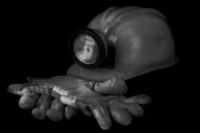Rulemaking activities
The agency also engaged in targeted rulemaking, publishing an emergency temporary standard on the Maintenance of Incombustible Content of Rock Dust, which became a final rule in 2011; in 2012, a final examination rule that requires operators of underground coal mines to conduct more thorough examinations to find and fix commonly cited hazardous conditions; and in 2013, a final POV rule aligning it with the original intent of Congress to rein in chronic violators.
Under the new POV rule, the monitoring MSHA did under the PPOV process is now the responsibility of operators, inspecting 11
and monitoring compliance at their own mines and taking corrective actions before a mine meets the POV screening criteria. MSHA has also developed web tools that allow mines to monitor their mine compliance under the POV criteria. Our latest tool is a new on-line S&S calculator, which we launched this past August.
To address the recommendations of the internal review, MSHA completed over 40 policy directives, including the extensive revision of the coal and metal nonmetal inspectors’ handbooks and the development of a new coal Roof Control Handbook. It conducted more than 20 training sessions for MSHA personnel on issues raised in the internal review and created and implemented a centralized system to establish better oversight of all agency directives and policy guidance to ensure their consistency.
MSHA also developed new inspection procedures for rockdusting underground coal mines to prevent coal dust explosions and began using these procedures last Spring. In addition, MSHA made many technological changes that we believe will improve the agency’s ability to do its job more efficiently.
Beginning in June 2012, MSHA posted its progress on a quarterly basis on the agency web site.
Through the dedication of MSHA employees---especially those in coal enforcement, headed by Kevin Stricklin, we met our end-of- the-year deadline and posted the remainder of our corrective actions on January 13, 2014.
In addition, MSHA has announced a new regulatory action in response to the internal review recommendations. MSHA intends to publish a Request for Information that will focus on important mine safety issues in underground mines, such as ventilation and rockdusting.
MSHA has been developing communication, tracking, mapping and atmospheric monitoring technologies to use during mine rescue that will speed up mine rescue efforts and make them safer.
Mine emergency response
Working with the mining community we have made other improvements in mine emergency response by creating the Holmes Mine Rescue Association, within the Holmes Mine Safety Association, to provide a national support structure and to provide guidance for mine rescue and training. Recent changes we made in the national mine rescue training contests have increased stakeholder participation; for example, the last coal training contest was sponsored by the National Mining Association. As required by the 2006 MINER Act, MSHA, with input from the mine rescue community, recently issued updated criteria for certifying mine rescue teams.
The state-of-the art training and mine emergency facility opened by Alpha Natural Resources in Julian, WVA this past June, is also an important asset to further mine safety and mine emergency response.
Like many of you here today, I have been actively involved in mine rescue over the years. We know that we owe our mine rescue teams the best training and guidance we can give them so they can be ready to respond at a moment’s notice when an accident occurs. Last October 30th, we declared that each October 30th will be recognized as “Mine Rescue Day” to honor mine rescuers---past, present and future---who place their own lives at risk to save others.
MSHA has been working with the mining industry and manufacturers of both refuge alternatives and components to implement the December 31, 2013 requirements of 75.1506(a)(3), which was issued on December 31, 2008. To implement those new requirements, MSHA has approved 17 breathable air, 12 harmful gas removal and 6 air monitoring components.
Revised POV process
Let me share the results of some of the actions MSHA has undertaken. We are continuing to use our special emphasis enforcement measures, such as impact inspections and the revised Pattern of Violations (POV) process implemented in 2010 to improve health and safety at mines with histories of violations. The good news is that we have not needed to use these tools as frequently as we did in the past. The safety culture of mining here in West Virginia and elsewhere is changing in a positive way and operators are improving their compliance with MSHA’s standards.
In our first year of POV screening following the revisions to the process, 53 mines were identified, 17 mines received Proposed Pattern of Violation (PPOV) notices and two received POV notices as a result. This year, during our fourth screening, MSHA identified nine mines for additional review, and four underground coal mines were given POV notices. MSHA’s POV actions have resulted in a significant reduction in mines receiving additional screening as chronic violators - down 83% from 2010 when the POV screening criteria was revised to focus on mines with the most serious compliance issues
In addition, a review of POV mines shows that as of December 31, 2013, these mines have improved their performance. Their total violation rates are down 37 percent; their S&S violation rates down 59 percent and unwarrantable failures down 78 percent; and lost time injury rates down 44 percent.
A review of mines receiving impact inspections between September, 2010 and September 30, 2013 that have had at least one follow-up inspection also shows that these inspections have made a real difference. As of December 31, 2013, violations per inspection hour were down 19 percent; S&S violations down 26 percent; unwarrantable failures down 52 percent; and lost time injury rates, down 13 percent.
Reducing the backlog
MSHA, with SOL, is also having success reducing the backlog of contested cases that existed since before I arrived at the agency in late 2009. From a high of about 89,000 contested citations and orders at the end of December, 2010, the backlog, as of December 31, 2013, stood at about 31,000 cases, or a reduction of more than 65 percent. The backlog is now down to 2008 levels.
From January 1, 2012 through January 11, 2014, we have resolved about 150,000 contested violations.
In January 2012, MSHA implemented a pre-contest conferencing process to resolve citations before they become a matter for litigation. Through December 31, 2013, MSHA had conferenced almost 8,000 violations, more than half of which were coal violations. Of the more than 7,000 cases that were resolved at conference, 60 percent of them were not further contested.
MSHA cannot be present at all mines all the time, so we rely on miners to bring hazardous conditions to the attention of the agency and mine management. Evidence from the investigations of the Upper Big Branch mine disclosed that we needed to do a better job of educating miners on their rights to speak out about their safety and also on enforcing those rights. MSHA is very committed to enforcing the rights of miners who have been retaliated against for making these complaints.
In 2013, the agency, working with the Department of Labor, filed 45 105(c) discrimination cases on behalf of miners, the most ever in a year, according to MSHA records. Last year, we filed 26 actions for the temporary reinstatement of miners who lost their jobs because they had exercised their rights under the Mine Act. The number of temporary reinstatement actions filed in 2013 was exceeded only by 2012, when we filed a record 47 cases.
MSHA continually updates the Miners Rights and Responsibilities page on its website, and this past year we developed a Miners’ Representatives Handbook, a comprehensive tool that expands upon the “Guide to Miners’ Rights and Responsibilities” released by the agency in 2011. The Handbook, along with a web-based training course to accompany the Handbook, is available on MSHA’s website.
Black lung disease efforts
In December, 2009, we launched the “End Black Lung—ACT NOW” campaign, a comprehensive strategy to end black lung disease involving targeted outreach, education and training, rulemaking, focused enforcement and collaboration with stakeholders.
In FY2013, operator Designated Occupation sample results recorded the lowest yearly average respirable dust concentration ever in underground coal mines at 0.70 mg/m3. Operator data also shows an approximately 9% reduction since we began the campaign through FY2013. Improvements in respirable dust levels are achievable, but more needs done to end Black Lung, a disease that has claimed the lives of thousands of miners.
MSHA is also improving occupational health in the workplace by issuing a new policy on HazCom to conform with global standards. Ensuring that miners have proper training is essential, and in 2013, MSHA audited 856 training sessions, the most sessions audited ever based on agency records.
As I noted earlier, MSHA is continuing its targeted rulemaking activities, focusing its efforts on those rules that will have the biggest impact on miner safety and health. The Department of Labor has submitted MSHA’s final rules on Lowering Miners' Exposure to Respirable Coal Mine Dust, Including Continuous Personal Dust Monitors and Proximity Detection Systems for Continuous Mining Machines in Underground Coal Mines to OMB for review.
Proximity detection technology in the underground coal mining industry is advancing and MSHA’s proposed rule on proximity detection systems for mobile machines has been withdrawn from OMB review to make refinements consistent with technological advancements.
Proximity detectors
While we continue to move forward on rulemaking, the industry continues to makes progress to implement this technology, and as of January 10, 2014, about 400 proximity detection systems had been installed on continuous mining machines and other mobile equipment. Alliance Resource Partners, LP has equipped its continuous mining machines with proximity detectors, and Consol Energy is also a leader in this area.
Since 1983, 77 miners have died in crushing accidents with mining equipment in underground coal mines. Thirty-four of those fatalities involved continuous mining machines. The use of proximity detection systems on mining machines in underground coal mines is among the best practices to prevent these crushing deaths.
We believe that all these collective actions and initiatives are improving mine safety and health in the nation’s mines. One measure of our success is that each year since 2010, compliance has improved as MSHA has issued fewer citations to operators. Between 2010 and 2012, the number of citations dropped by 18 percent. Last year the number dropped an additional 15 percent from 2012; it dropped 20 percent for coal. It is recognized that the reduced number of mines contributes to some of this reduction.
But of course the most important measure is how many miners return home at the end of their shift without illness or injury. To that end, the mining industry had the lowest fatal and injury rates in 2011 and again in 2012. That trend continued in fiscal year 2013, as preliminary data showed a record-low fatality rate of .0104 and an injury rate of 2.42, as well as the lowest number of mining deaths at 33 for a fiscal year. However, as I have said the fourth quarter did not follow that trend with 15 fatalities, a significant increase from the same period in 2012 when 6 miners died.
Certainly, the progress we have made in mine safety in recent years lets us know that greater improvements are achievable. Together we can make that happen. We owe the nation’s miners that much.
I know that President Obama and Secretary of Labor Tom Perez share this goal. Going forward, we will continue to focus on our mission to prevent death, disease and injury and to promote safe and healthy workplaces for all miners.

